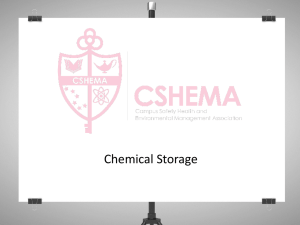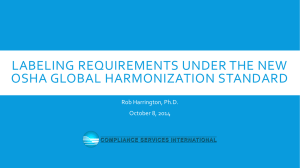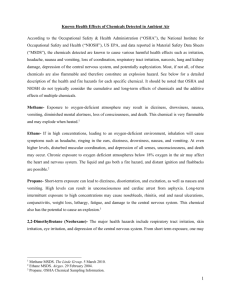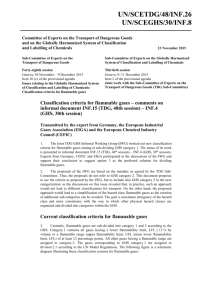Richfield Public Works Right to Know / Infectious Agents
advertisement
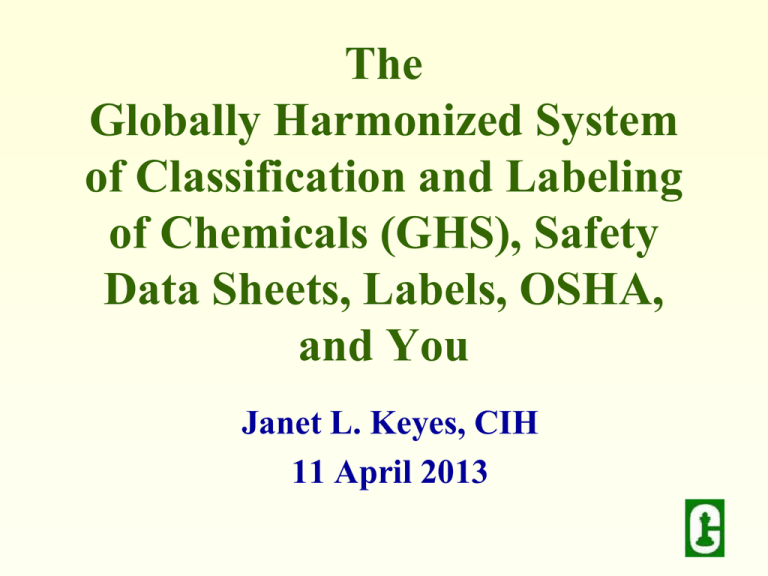
The Globally Harmonized System of Classification and Labeling of Chemicals (GHS), Safety Data Sheets, Labels, OSHA, and You Janet L. Keyes, CIH 11 April 2013 What’s GHS? Why? Lots of chemicals out there Lots of international trade Can’t we just agree? 1992, Rio, UN Conference on Environment & Development 2002: first version approved 2012: OSHA adopted What GHS tries to do Classify chemicals according to hazard Standardize the language, warnings Make it easier for: Suppliers/manufacturers Users And not conflict with transport GHS in the US OSHA: adopted Revision to HazComm standard and others EPA: pondering Pesticides DOT: adopted in hazmat (49CFR) regs CPSC: began considering Federal Hazardous Substances Act What does OSHA’s adoption of GHS mean? 2013, December 1: Employees trained on labels, SDS 2015, June 1: MSDSs replaced by SDSs Your SDSs updated 2015, December 1: No old labels shipped 2016, June 1: in-house labels updated Other standards change All substance-specific hazards (e.g., lead), Welding standard Change warning sign language Laboratory, PSM, Hazwoper Flammable Liquids (use, spray, dip) Change definitions Combustibles (IIIB) goes away What’s changed in HazComm? • Classification of hazards – – – – Based on specific criteria Physical hazards – 16 classes Health hazards – 10 classes Environmental hazards – 2 classes • Standardization of language – For hazard statements and for precautionary statements Physical hazard classes 1 Explosives 2 Flammable Gases 3 Flammable Aerosols 4 Oxidizing Gases 5 Gases Under Pressure 6 Flammable Liquids 7 Flammable Solids 8 Self-Reactive Substances 9 Pyrophoric Liquids 10 Pyrophoric solids 11 Self-Heating Substances 12 Substances Which in Contact with Water Emit Flammable Gases 13 Oxidizing Liquids 14 Oxidizing Solids 15 Organic Peroxides 16 Substances Corrosive to Metal Health hazard classes 1 Acute Toxicity 2 Skin Corrosion 3 Skin Irritation 4 Eye Effects 5 Sensitization 6 Germ Cell Mutagenicity 7 Carcinogenicity 8 Reproductive Toxicity 9 Target Organ Systemic Toxicity: Single Exposure & Repeated Exposure 10 Aspiration Toxicity Environmental Hazard Classes Not mandated by OSHA Not yet required by EPA Acute aquatic toxicity Chronic aquatic toxicity based on fish, crustaceans, algae Hazardous to the ozone layer Other Classes Specific to OSHA Not part of UN GHS Simple asphyxiant such as helium, nitrogen Combustible dust flour dust, grain dust Pyrophoric gases Washburn A Mill, 1878 Material safety data sheet: Really old version Not that you can read this small type... Material Safety Data Sheet ANSI 16-part Not that you can read this small type... Safety Data Sheet: GHS version Safety Data Sheets will still have: 1. 2. 3. 4. What is it, what’s in it – Section 1 & 3 What’s the hazard – Section 2 Emergency info – first aid, fire, spills Safe use, handling and storage – Recommended PPE 5. How it behaves 6. Toxicology 7. Not mandatory: ecotoxicity, disposal, transport, regulatory Order will be consistent 1. 2. 3. Identification Hazard(s) identification Composition/information on ingredients 4. First-aid measures 5. Fire-fighting measures 6. Accidental release measures 7. Handling and storage 8. Exposure controls/personal protection 9. Physical and chemical properties 10. Stability and reactivity 11. Toxicological information optional 12. Ecological information 13. Disposal considerations 14. Transport information and 15. Regulatory information. required 16. Other information, including date of preparation or last revision. SDS Section 2 - acetone Similar to label Old labels Labels are changing 1. Pictograms 2. Danger or Warning signal words 3. Hazard statement & Precautionary statement DOT placard can be used of pictograms on original shipping container Hazard Statement for a paint thinner Danger: Highly flammable liquid and vapor. May be fatal if swallowed and enters airways. Causes damage to liver or nervous system through prolonged or repeated exposure if inhaled. Causes skin irritation and serious eye irritation. May cause drowsiness or dizziness. Precautionary Statements for a Thinner (in part) Prevention Keep away from ignition sources such as heat/sparks/open flame Ground/Bond container and receiving equipment. Use only outdoors or in a well-ventilated area. Do not breathe vapors or spray. Wear protective gloves and eye/face protection as specified… Response In case of fire, use a fire extinguisher rated for Class B fires. Do not use water. IF IN EYES: Rinse cautiously with water for several minutes. If eye irritation persists, get medical advice/attention. Wash hands after handling IF ON SKIN: Wash with plenty of soap and water. Take off contaminated clothing and wash before reuse. If skin irritation occurs, seek medical attention. Storage Store container tightly closed in cool, well ventilated place. Store locked up. Disposal Dispose of contents in accordance with local, state, and federal regulations. Pictograms Meant to quickly convey hazard Always: Diamond black & white, red border Similar to DOT placards Nine types Know what they mean? You probably do This symbol is used for: 1. Flammables 2. Gases under pressure 3. Things that can hit you 4. Paddles Which products would get this symbol? 1. 2. 3. 4. Muriatic acid Oxygen LP gas Isopropyl alcohol Only application: gases under pressure Gases under pressure symbol includes: Compressed gases ≥29 psi Liquefied gas Refrigerated liquefied gas Dissolved gas (acetylene) This symbol is used for: 1. 2. 3. 4. Fireplaces Oxidizers Flammables Things that you can smoke Which products would get this symbol? 1. 2. 3. 4. Acetone Isopropyl alcohol Latex paints Battery acid Flame symbol is for: Flammable liquids Flammable aerosols, too Flammable gases Flammable solids Pyrophorics Self-heating Self-reactive Emit flammable gas Organic peroxides Fire Hazard Examples Flammable solids: aluminum powder, magnesium ribbons Pyrophorics: organometallics, silane Self-heating: linseed oil rags Flammable gases: acetylene, hydrogen Self-reactive: acetylene, azides Emit flammable gas: lithium, calcium carbide Organic peroxides: MEK peroxide Flammable Liquids are divided into categories Category 1 = higher hazard Category Flash point Boiling point 1 2 <23ºC (73 ºF) <35ºC(95 ºF) <23ºC (73 ºF) >35ºC (95 ºF) 3 Between 23ºC & 60ºC (73 - 140 ºF) Between 60ºC & 93ºC (140 - 200 ºF) 4 This symbol means the chemical: Oxidizer 1. Is surprised 2. Is highly reactive 3. Will contribute oxygen and promote fires 4. Is highly flammable ? Which products would get this symbol? 1. 2. 3. 4. Nitric acid Silica LP gas Oxygen Only application: oxidizers This symbol means the chemical: 1. Can explode 2. Decomposes 3. Will blow up easily 4. Catches fire easily ? Which would get this symbol? 1. 2. 3. 4. 5. Ammunition Aerosol cans Fireworks Acids Oxygen Exploding Bomb symbol is for Explosives Self-reactives Organic peroxides Unstable – by themselves, cause violent chemical reaction ? This symbol means 1. The fishing’s bad 2. The chemical is an environmental pollutant 3. Trees kill fish 4. You’re a bad fisherman This symbol means the chemical: 1. Will cause burns or strong irritation 2. Will damage pirates who drink it 3. Is acutely toxic 4. Will try to take over the world Skull and Crossbones criteria are different than for consumer products For chemicals that can kill at pretty low doses Won’t apply to many chemicals in commercial use Acutely Toxic is divided into categories Category 1 = higher hazard Category Amount to kill 50% of test animals (LD50) Example 1 2 3 5 mg/kg Cyanide, nicotine 50 mg/kg Hydrogen sulfide 300 mg/kg Carbon monoxide 4 5 2000 mg/kg 2,4-D 5000 mg/kg Sulfuric acid ? This symbol means the chemical: 1. Can cause acute toxicity 2. Dissolves metals 3. Has a pH of 7 or more 4. Causes skin burns or severe eye irritation ? Which products would get this symbol? 1. 2. 3. 4. 5. Battery acid Isopropyl alcohol Nitric acid Carbon monoxide Amorphous silica Corrosion symbol is for: Skin corrosion/burns Severe (permanent) eye damage Corrosive to metals pH ≤2, ≥11.5 Not as corrosive irritant ? This symbol means the chemical can: 1. Makes your chest explode 2. Cause long term health harm 3. Cause cancers 4. Cause allergic lung reactions (asthma) more than one correct answer ? This symbol means the chemical is: 1. An alien that sucks out your lifeblood 2. A skin penetrant 3. A specific target organ toxicant 4. Blow up in your face The exploding torso is used for: Respiratory sensitizers Mutagens Carcinogens Reproductive toxicants Specific target organ toxicity (single or repeated exposure) Aspiration hazard Serious health hazards, short of death ? This symbol means the chemical: 1. Could cause irritation or allergic skin reactions 2. Can burn intensely 3. Can cause asthma 4. Should be listened to ? This symbol means the chemical could: 1. Make you a more sensitive, caring person 2. Rapidly decompose 3. Give you pimples 4. Make you dizzy and lightheaded Exclamation point symbol will be for: Health hazards, but not that severe irritant to eye, skin, breathing skin sensitizers narcotic effects And hazard to ozone layer How to tell how nasty something is Signal word present? Danger > Warning > None Pictogram present? > Hazard statement Extremely > highly Fatal > toxic > harmful > none Hazard Categories 1 3 0 How do these fit in? Not required If you use in-house, train Watch for conflict with GHS (e.g., flammability) Potential confusion: 1=bad (GHS); not bad (these) 2 3 Your Next Steps 1. Learn the pictograms 2. Train your workers – Emphasize labels 3. Start updating data sheets 4. Take a look at in-house labeling Questions? Resources: OSHA quick cards on SDS, labels, pictograms http://www.osha.gov/dsg/hazcom/ghsquickca rds.html Me: Jkeyes@chess-safety.com




